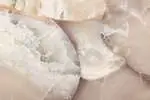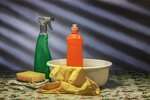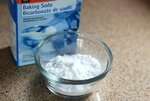From floors to countertops, marble makes the place beautiful now matter where you use it. But this natural stone is also susceptible damage and stains. Here, we will tell you everything you need to know to make homemade marble cleaner.
The best part about this is, you won’t run out of your marble cleaner ever again. You can always make it on your own when you have all the supplies you need. This do it yourself marble cleaner will be safe to use in your home without any hazardous chemicals.
So, let’s get started.
Making Do It Yourself Marble Cleaner

Here we will describe how you can make your do it yourself marble cleaner using a dish soap that’s easily available in every house. It will allow you to save a lot of time and money because all those commercial marble cleaners are somewhat expensive.
What is needed?
- A spray bottle.
- Dish soap (mild).
- A white towel.
- A microfiber or chamois towel.
- Water.
- A mixing spoon or any other mixing tool.
- A bowl or a bucket.
Process
You won’t have to go through a lot to make a do it yourself marble cleaner. Just add a quarter or a half-gallon of water into your bowl or bucket. Now add a couple of drops of your mild detergent or soap into your bucket of water. Then, stir using your mixing tool or spoon for about half a minute, so the detergent mixes well with the water. You will notice that the mixture will begin to bubble and turn soapy.
It is essential to stir both the ingredients well for activating those surfactants. These are the active ingredients in your soap or detergent to increase its cleaning power. You will know when these surfactants are activated when you see bubbles in your mixtures.
It’s time to apply this mixture to your marble surface. If you want to clean any spills, make sure you quickly wipe up the spill, especially if it’s acidic like a wine. The reason for that is, acidic substances begin to etch the surface, and you don’t want that to happen, or your marble will get damaged in that area. So, make sure to get even that stain from the spill as well.
Now apply your do it yourself marble cleaner. We recommend using it with a spray bottle because it can even spread the cleaner throughout the surface. But if you don’t have a spray bottle, you can always pour the fluid in drops onto the surface. Make sure to cover the surface with the cleaner completely.
Now use your towel and wipe down the surface. Make sure to do the wiping in a circular motion and cover the entire surface completely.
How to Remove Etch Marks?

If there is a dull mark left on the surface where the spill occurred, it’s a possibility that you have ended up etching your surface. It generally happens when the acidic spill remains on the surface for a longer period. This is why we emphasized quickly wiping, especially if it’s acidic. But don’t worry, all is not lost here.
Etching occurs when the acidic fluid that spilled on the surface reacted with the marble. It dissolves some parts of the marble. You can rub your finger over the mark and feel the rough patch. You will have to repolish that section of your marble surface and buff it.
What do you need?
- A marble etch remover.
- A white towel.
- Clean water.
- A spray bottle.
- A pair of rubber or latex gloves.
Process

First of all, you need to wipe the surface clean, particularly the etched area. Get rid of any grit or dirt from the area. Use your etch remover, a polishing powder that will start blending the etched mark by filling it. It will smoothen the rough area for blending.
Using MB 11 etch remover or polishing powder for this purpose is safer. While applying the remover, you must make sure the powder completely covers the etch mark. Now spray water over it using the spray bottle right over the polishing powder. You can spray a couple of times to dampen the powder.
Now dampen the towel and gently start scrubbing the etched mark. Spray your towel at least a couple of times with water before you begin scrubbing the mark. Take your time when scrubbing, as you will have to do it for about a minute. You will notice the etched mark starts to vanish.
In the end, use your do it yourself marble cleaner with the help of a spray bottle. And wipe the surface with a clean towel. Just make sure to wipe it all dry, and there is no polishing powder or cleaner left on the surface.
Tips on choosing a dish soap

- You must keep in mind to only use mild dish soap or detergent for this purpose. Otherwise, you will end up damaging your marble significantly. So, you will end up doing more harm than good.
- You need to look for the words mentioned on the bottle of the cleaner, saying “easy on hands” or “soft.” Such a dish soap or detergent will be mild, and you need to go for this because you won’t damage your hands this way.
- Do not pick the cleaner with a label saying “for commercial use” or “commercial cleaner.” These cleaners are very abrasive, and they tend to damage your marble.
- Usually, every household has a mild detergent or soap, and you won’t have to do a lot of research for that. If you don’t have one in your house, it is recommended to go for a marble cleaner, but a mild one.
- Don’t consider going for any antibacterial dish soaps because they are not designed for cleaning marble floors and tile floors. In short, you need to avoid any abrasive cleaners at all costs.
Mild Soap/Detergent Alternatives

You can use some other alternatives instead of mild soap or detergent if you don’t want to use it or don’t have it for the time being.
Baking soda is a great alternative. It works just like ammonia but is less volatile. However, you still want to use it carefully with warm water. You can use 3 tablespoons of baking soda in a quart of warm water to make a solution. And use a microfiber cloth in the end to remove any traces of baking soda from the surface.
Castile soap is one of the best alternatives you can use for cleaning your marble. It’s an excellent stone cleaner. You can also use it for cleaning granite surfaces. It comes cheap and works exceptionally well to get rid of those water stains from the surface.
You can also use ammonia for cleaning your marble surface. It’s not acidic but has natural cleaning abilities. Just make sure you mix your ammonia with water to make the solution. When you dilute it enough, you will be able to extract some great cleaning benefits from it.
It would be better to use half a cup of ammonia in a gallon of hot and distilled water. Keep in mind that distilled water or ammonia will react with the minerals present in your water and cause more damage.
FAQ
What should I do to remove organic stains?
These stains are caused by fruit, tea, or coffee. These are tough to remove, and you can use the rust remover poultice for this purpose.
What can I do to clean my cultured marble?
Cultured marble is slightly different than natural marble. It has a resin finish but is non-porous and more resistant to stains. While it’s more durable than natural marble, you still need to take care of it to increase its overall lifespan.
You don’t need to use those abrasive chemicals and cleaners on this surface. However, you can use slightly more acidic substances like vinegar. But be sure to dilute your solution. Vinegar is the most effective option to go for if you have cultured marble in your home.
How can I remove those oil-based stains from my marble surface?
These stains occur due to cooking oil, cosmetics, or grease. But these stains are a bit easier to remove if you compare that with rust stains. Your home-based do it yourself marble cleaner is going to be very effective in handling these stains.
How can I remove rust stains from my white marble?
These rust stains begin to appear when you leave your metallic objects on the surface, like your appliances or utensils. These are tough to remove, and you will need commercial marble poultice to treat them. But make sure to use gloves and keep the cleaner in the affected area. Apply the paste and leave until it dries. Scrap it off with a plastic scraper. You might have to do it multiple times to remove the stains.
Conclusion
Making your do it yourself marble cleaner is an easy thing to do. You can make it by using supplies that are already available in your home.
Mild soap or detergent is a good choice for your do it yourself marble cleaner solution, but there are some alternatives. These include the likes of baking soda, ammonia, and in the case of cultured marble, you can go for vinegar. But make sure your solution is diluted enough, so it doesn’t end up causing more harm than good.


